
Santa Cruz Carbon V10
After spending two solid days riding the new V10 Carbon at the Whistler bike park I can say that it is no longer a niche bike. It is still a nice bike – actually nicer than ever – but it is no longer a niche bike. Previous aluminum V10s had a unique set geometry numbers. Most notably the 10” of travel combined with the 67 deg head angle. Endless debates raged on the web boards a couple of years ago about these two numbers. Many were asking why you would buy a full downhill race bike with a 67 degree head angle. The truth and the real answer to the question was that because the bike also had 2-3 inches of negative travel the true head angle under preload was less than the 67” found in the geometry charts. At the time there were still people who thought it was a strange combination. Now with the soon to be released (Santa Cruz is accepting the first orders late summer for delivery late fall) V10 Carbon, the wrangling is no longer relevant.
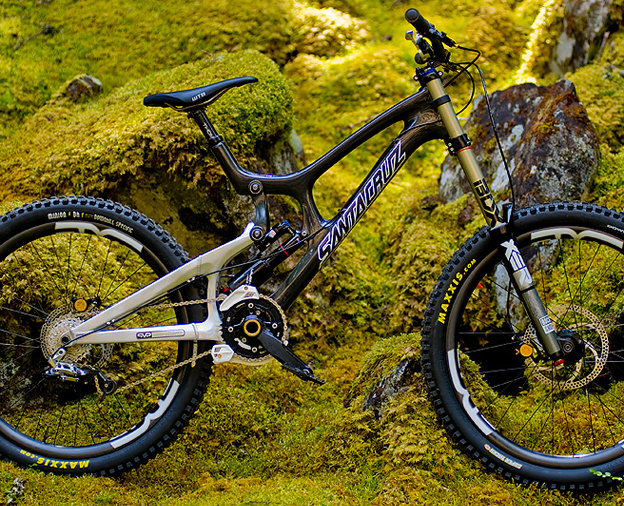
The new V10 has very generous standover clearance and lines that ooze smooth.
The V10 Carbon has a lot of new features. The most obvious is that the front triangle is now carbon, extremely light and reported to be extremely strong. The headtube is 1.5 inches, the rear travel is now adjustable between 8.5” and 10” and the head angle – with the supplied Cane Creek Angle Set headset – is now adjustable between 63 – 66 degrees depending on the travel setting. The rear end has been beefed up with new larger pivots and bearings and a longer rear shock that reduces the leverage ratio.
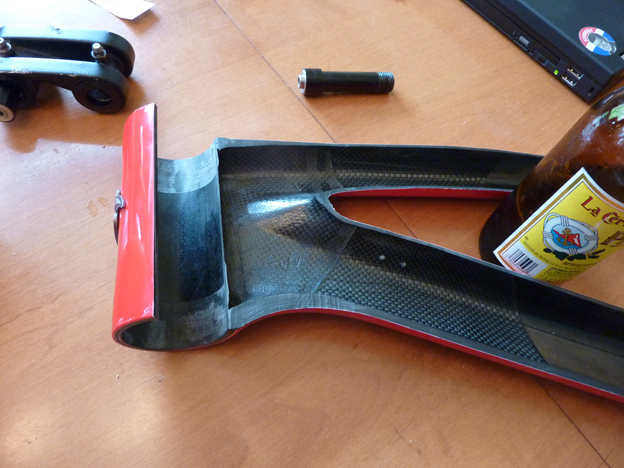
The engineers at Santa Cruz – all of whom were in attendance at Whistler – opted for smaller diameter tubes so that the wall thickness could be increased for more durability. Photo ~ Cam McRae
The front triangle upon first glance is very modern, smooth and elegant. The tubes are smaller in diameter than we are used to on a carbon bike. The engineers at Santa Cruz and in particular Nick Anderson, the lead designer on the project, opted for relatively small diameter but very thick walls. Unlike a typical thin-walled cross country bike they reasoned, a downhill bike needs to be able to withstand regular impacts. These impacts can be from crashing or flying rocks but the bottom line is the tubes were made thick to handle DH abuse.
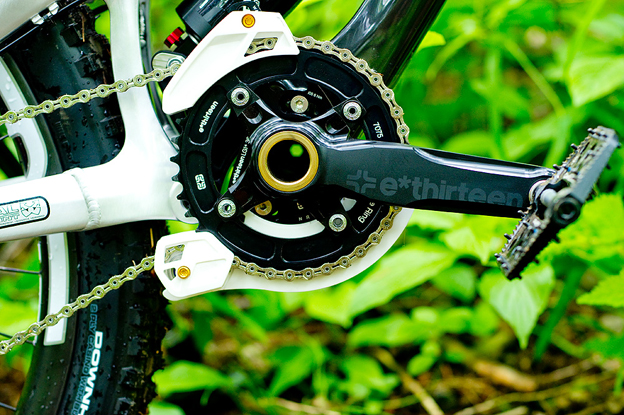
The new frame is taco approved. Now with ISCG 05 tabs, using a taco instead of a bashguard no longer voids your warranty.
Stress testing has shown the resulting frame to be significantly stronger than the aluminum version. Although time and lots of Joe Riders abusing the frame will be the true test, the early signs are good. The Syndicate has already been riding these frames for a few months with great success according to Santa Cruz. The engineers let it slip that the Syndicate boys go thru a set of rims on almost every race run (Note – this refers to aluminum rims. Edge Carbon rims last much longer according to SC). That tells you just how punishing these guys are on their bikes. Another indicator of the strength of these frames is that, unlike they aluminum versions, the integrated carbon ISCG05 tabs are now taco bashguard approved (no longer voiding the warranty). During the impact testing of the taco mounts the bashguard eventually broke apart before the mounts were damaged.
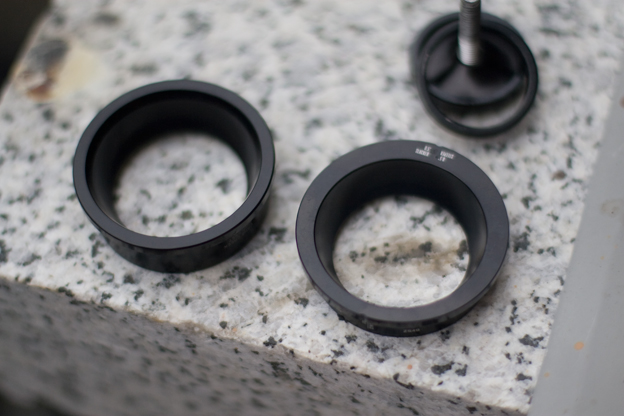
Two of the three top cups that will come stock with a Carbon V10 frame. You’ll notice the cup on the right is offset to allow you to alter the headangle – while the cup on the right preserves the stock angle. Photo ~ Cam McRae
As mentioned, the new head tube is 1.5”. This again increases strength but more importantly allows Santa Cruz to adjust head angle with the new Cane Creek Angle Set headset. More on this later. Normally the use of the larger 1.5” headset comes at the expense of additional weight but that is no longer a concern when you build it out of carbon.
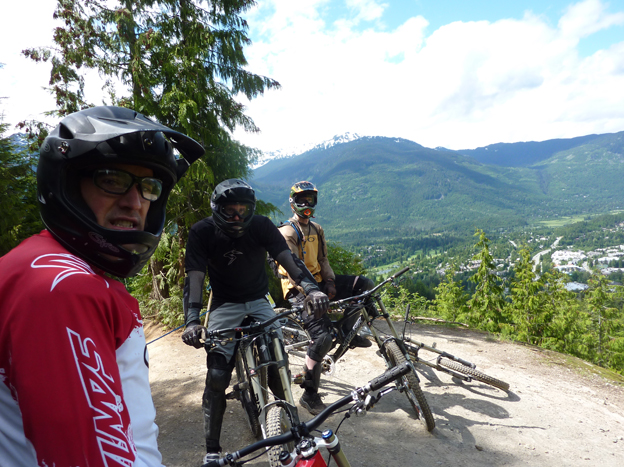
You have to like engineers who rip. We rode with Nick Anderson (left) and Steve Janssens (middle) on the first day and they tore it up. Mike Wallace who penned this article is on the right. Santa Cruz product manager Josh Kissner was the fastest of the crew – and wouldn’t stay still long enough to be photographed. Photo ~ Cam McRae
Santa Cruz decided to keep the rear triangle aluminum. In fact the rear triangle design is shared with the Driver 8. The engineers said that although it was very tempting to go for the fully pimped 100% carbon frame the manufacturing issues involved in making a carbon rear triangle which was impact resistant, chain slap resistant and light were too numerous and cost prohibitive – and little or no weight would be saved. That said, the new rear triangle is still much more pimped and finished looking than on previous V10 models.
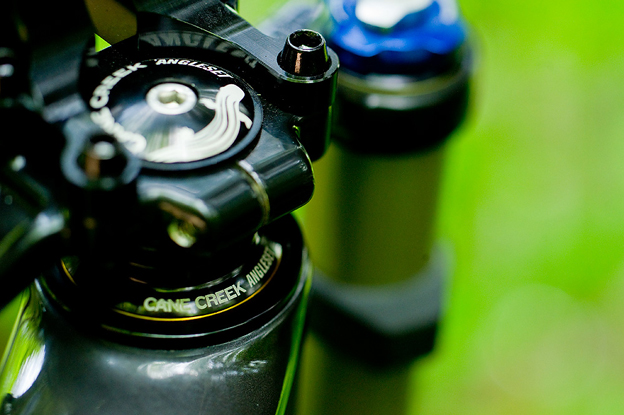
The Cane Creek Angle Set installed. It has a slightly taller stack height than their other 1.5 – 1 1/8 reducing models but it’s still nice and low.
The new size-medium frame and coil shock weighs 9.6 lbs or 8.6 lbs with a Vivid air shock (split the difference with a Ti spring). There will be 3 shock options when you buy a frame. The frame will come standard with a Rock Shox Vivid coil but can be swapped for either a Vivid Air or a Fox DHX RC4 Coil. There may be a Cane Creek Double Barrel option as well. The V10 carbon now comes with a 9.5 X 3.0 shock vs. the aluminum bike that used a 8.75 X 2.75. This reduces the leverage ratio and in theory reduces forces and wear and tear. Santa Cruz engineers said that the shock manufacturers have seen better durability on the World Cup circuit with a larger, higher volume shock. One characteristic of the new bike’s shock rate curve that I like is that it continues to ramp up at the end of travel. The old V10 had quite a flat shock rate curve and actually fell slightly at the end of the travel (curves can be seen below). This means the rider no longer has to use shock settings to get ramping at the end of the stroke and can run more linear settings oto get a little more out of the shock. 

The bearings and pivots on the new V10 are actually larger and heavier than on the aluminum model. There are now well-protected grease ports that allow the rider to easily re-lube the bearings after a few months of riding or after a few weeks of riding in the west coast rain. The engineers made a point of saying the huge weight savings with the carbon frame allowed them to beef up the pivots and bearings and shock while still producing a frame with a lower overall weight.
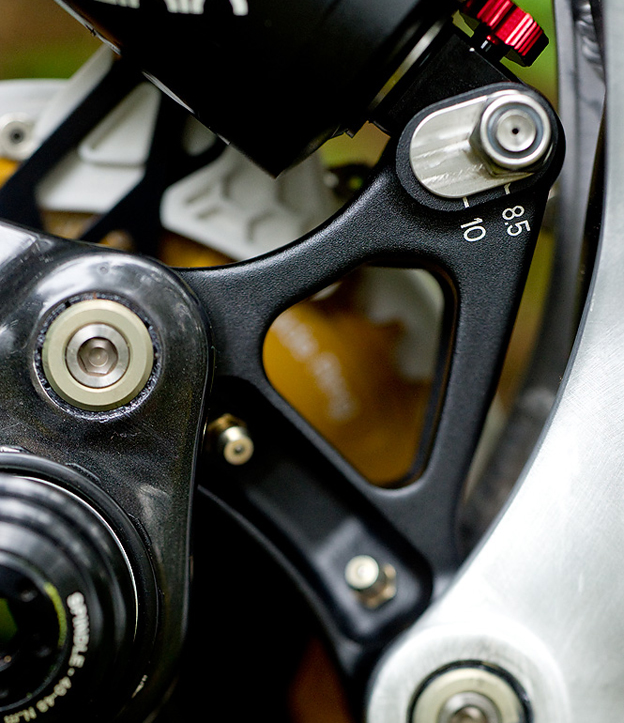
Assuming you don’t need to change a coil spring, swapping from 8.5″ to 10″ mode is a snap. Notice the absence of pinch bolts. Bearings are held in place with an internally expanding collet mechanism. Lower pivots also have grease nipples to improve performance and bearing life.
The rear travel on the new V10 Carbon has two settings. The tried and true 10” setting plus a new 8.5” setting. This allows the V10 to compete with the many other 8-9” downhill bikes on the market if that is what the rider prefers. The new shorter travel setting eliminates a lot of the negative travel or sag that is characteristic of the 10” mode. Some riders prefer the more lively feel the 8.5” setting serves up. By reducing the travel other angles and measurements change. This is where the intelligence of the new Santa Cruz design comes to the forefront. Reducing the rear wheel travel of course slackens the head angle and reduces bottom bracket height. This is not something you would necessarily want as riders often want quicker handling (steeper head tube angle) when running a shorter travel bike. When Santa Cruz engineers heard from those at Cane Creek about the Angle Set they knew they had their solution. The different cups that will be shipped with the frames allow the head angle to be adjusted in half degree increments. The range for the 10” travel position is 64-66 deg and the range for the 8.5” setting is 63-65 deg. The new V10 will ship with three top cups; a 0 degree, 0.5 degree and a 1 degree. The 0.5 and 1 degree cups can be used in one direction to steepen the head angle or in the other to slacken it. This means that in each travel setting you have five different head angle options. Because the bottom cup acts like a ball joint it doesn’t need to be changed to mate with the top cup. Cane Creek is also making a 1.5 degree cup for those who want to get xxxtreme (or to fix badly designed frames).
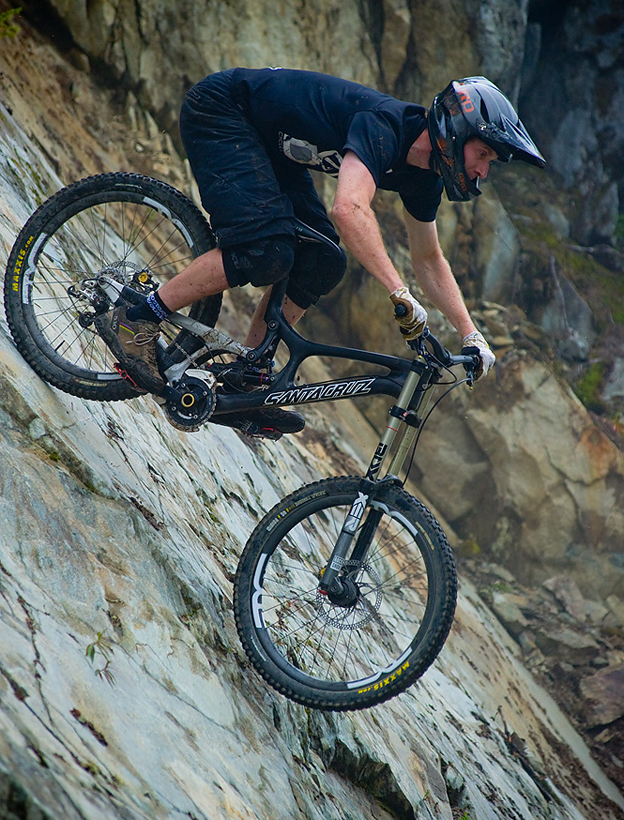
Scott Pilecki testing out the new slacker head angle. With his elbows out this time.
Different riders in different parts of the world have different needs and this is perhaps the most elegant solution to an adjustable headtube. I for one am no fan of pinch bolts on the head tube like those found on some other designs – particularly when I misjudge a launch or jump and come down nose heavy.
During our two test days at Whistler we rode the new V10s with coil shocks, air shocks, in 10” mode, 8.5” mode and with a variety of head angles. Cam and I made changes or swapped bikes and then had the advantage of being able to ride the same run minutes later with the different settings. In 10” mode with the 65-66 deg head angles the ride was not a lot different than the aluminum V10. This is a good thing. With its 2-3” of negative travel the V10 plows through rough stuff like no bike I have ridden. The weight difference of the carbon bike is noticeable all the time however. The V10 in 10” mode is not a poppy bike but the very low mass of the bikes helped to overcome that. Getting the bike airborne on small hits or up and over roots and rocks was easier than with an aluminum V10. The absence of fat also takes a bike that pedals well, due to the VPP technology – and notches it to the next level. The new carbon bike is even quieter than the aluminum V10. I have always found it quiet on the trail but this trait also hits a new standard with the addition of carbonium. 

The 2011 long-travel Vivid air shocks are impressive. They of course are much lighter than a coil (approximately 1 lb when compared to a steel-coiled shock) and I could only feel a difference in performance when the trail was very rough and fast. Personally I’d stick with the coil because they do everything extremely well. We heard that the Syndicate is only running the coil shocks on the nastier race courses.
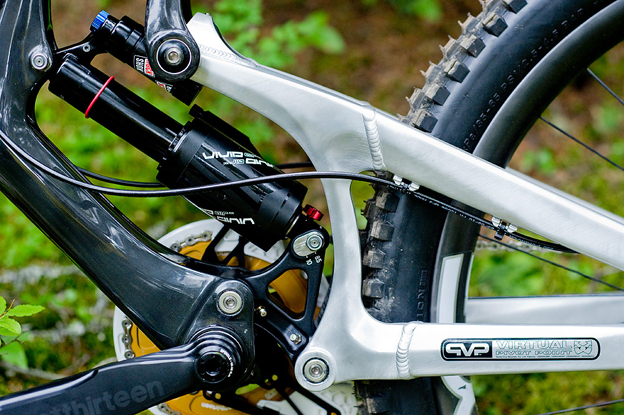
The Vivid Air shock performed impressively while saving a full pound over a steel-sprung coil. The rear end of the new V10 is identical to the swingarm on the Driver 8.
Switching to 8.5” mode was very interesting as the V10, in its earlier versions, was defined by its ‘extra’ travel. The bike still felt very good in the 8.5” setting. It was slightly more lively but not as plush when the trail got rough and ugly. I would say the choice would depend on the type of rider you are. If you prefer to choose a line and hold on then the 10” setting is for you. If you prefer to pop up and across the trail to change lines then I think the 8.5” setting may be better. In the bike park we preferred the 10″ setting. One thing to note is that because the spring rate changes you will need a second coil that is 50lb heavier if you plan to switch between 8.5” and 10” mode, but if you choose the air shock you just need to pull out your shock pump. Changing the travel setting – assuming no coil swap is needed – is a quick and easy operation.

The head angle changes offered up exactly what you would expect. On lower Joyride when things got fast and steep and rough, the 64 felt great. The increased rake of course becomes a little more work when trying to hammer through the tight and twisty, but not too steep, Karate Monkey.

The result of all these design changes by the engineers at Santa Cruz is that, as I mentioned earlier, the V10 is no longer a niche bike. If you want a point and shoot, mach through everything race bike then that still exists. Actually even more so because now you can rake it out to a 64 deg head angle (before sag). However if you want a more responsive ride where you can move the bike around, pop over roots and get a little more height on your jumps then that option now exists as well. The icing on the cake is that these frames can easily be built up to 35-37 lbs with pedals and Whistler ready parts. The bikes we rode (more on the spec later) were a shocking 33.5 lbs without pedals.
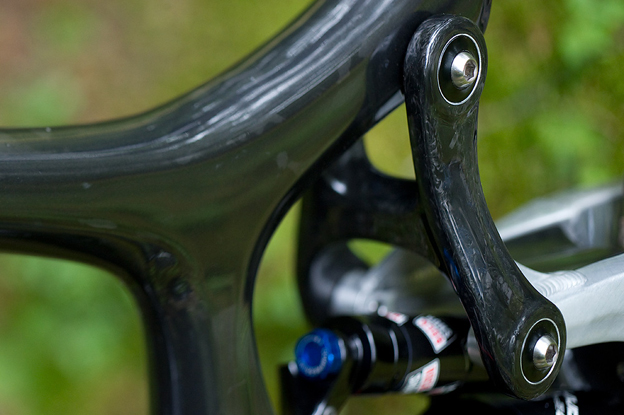
Almost too pretty to ride.
Frame size choices have changed significantly on the carbon model. For carbon production cost and simplicity reasons Santa Cruz designed the large size so that the Syndicate riders (the smallest is Josh Bryceland I at 6’2”) could ride it. Making a specific mould for the Syndicate is a $35,000 endeavour. This means the large carbon bike has a full 1.6” longer wheelbase than the aluminum large. Cam, who is 6’ tall, found the medium V10 a little short from pedals to bars but the large would likely have been a little big. Full geometry comparison can be found below.

Scott looks concerned in this photo
Cost of the frames with the Vivid coil are $2995 in the US and $3295 in Canada. The aluminum V10 is now a collector’s item; no more will be made once the carbons begin rolling out. Warranty is skookum with a lifetime crash replacement (at a cost but much reduced) and a two year design manufacturing guarantee.
Are you lusting after one of these? We certainly are. Any more comments or questions about Scott’s riding style, thick tubes, ball joints or 10″ in the rear? Toss ’em over here…









Comments
Please log in to leave a comment.